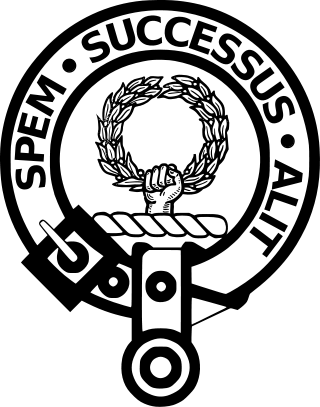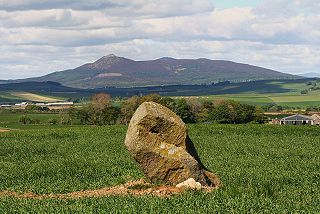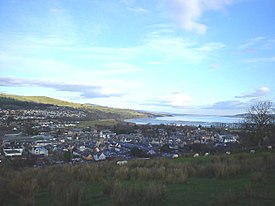
Clan Ross is a Highland Scottish clan. The original chiefs of the clan were the original Earls of Ross.

The Battle of Harlaw was a Scottish clan battle fought on 24 July 1411 just north of Inverurie in Aberdeenshire. It was one of a series of battles fought during the Middle Ages between the barons of northeast Scotland against those from the west coast.

Clan Donald, also known as Clan MacDonald, is a Highland Scottish clan and one of the largest Scottish clans. The Lord Lyon King of Arms, the Scottish official with responsibility for regulating heraldry in that country, issuing new grants of coats of arms, and serving as the judge of the Court of the Lord Lyon, recognises under Scottish law the High Chief of Clan Donald. Historically the chiefs of the Clan Donald held the title of Lord of the Isles until 1493 and two of those chiefs also held the title of Earl of Ross until 1476.

Clan Mackay is an ancient and once-powerful Highland Scottish clan from the far North of the Scottish Highlands, but with roots in the old Kingdom of Moray. They supported Robert the Bruce during the Wars of Scottish Independence in the 14th century. In the centuries that followed they were anti-Jacobite. The territory of the Clan Mackay consisted of the parishes of Farr, Tongue, Durness and Eddrachillis, and was known as Strathnaver, in the north-west of the county of Sutherland. However, it was not until 1829 that Strathnaver was considered part of Sutherland when the chief sold his lands to the Earls of Sutherland and the Highland Clearances then had dire consequences for the clan. In the 17th century the Mackay chief's territory had extended to the east to include the parish of Reay in the west of the neighbouring county of Caithness. The chief of the clan is Lord Reay and the lands of Strathnaver later became known as the Reay Country.

Clan Sutherland also known as House of Sutherland is a Highland Scottish clan whose traditional territory is the shire of Sutherland in the far north of Scotland. The chief of the clan was also the powerful Earl of Sutherland, however in the early 16th century this title passed through marriage to a younger son of the chief of Clan Gordon. The current chief is Alistair Sutherland who holds the title Earl of Sutherland.
Mariota, Countess of Ross was the daughter of Euphemia I, Countess of Ross and her husband, the crusading war-hero Walter Leslie, Lord of Ross. Upon the death of her brother, Alexander Leslie, Earl of Ross, she became the heir-presumptive of her niece Euphemia II, Countess of Ross although her husband Domhnall of Islay, Lord of the Isles pressed Mariota's superior claim to the earldom.

The Battle of Bealach nam Broig was a battle fought between Scottish clans from the lands of north-west Ross, against north-eastern clans of Ross who supported the Earl of Ross. The actual date of the battle is debated, it probably occurred in 1452 but the Conflicts of the Clans suggests a date as early as 1299.

The Battle of Drumchatt was a Scottish clan battle that took place in 1497. The Clan Mackenzie and possibly the Clan Munro defeated the Clan MacDonald of Lochalsh at Drumchatt (Druimchat) or "the Cat's Back", a ridge to the southeast of Strathpeffer.

The Battle of Tuiteam Tarbhach was a Scottish clan battle in which the Mackays wiped out raiders from the Clan MacLeod of Lewis who were returning from an attack on Mackay land in Strathnaver. The Mackays caught up with the raiders on the north bank of the River Oykel some three miles west of where the river joins the River Cassley at the head of the Kyle of Sutherland. The battle probably took place in 1406, but the date is uncertain from the manuscripts.

The Battle of Harpsdale was a Scottish clan battle fought in 1426 at Achardale, about 8 miles (13 km) south of Thurso. The Clan Mackay had invaded Caithness from the west and Harpsdale was where the local Clan Gunn chose to make a stand. Despite great slaughter on both sides, the battle appears to have been inconclusive.

The Battle of Drumnacoub was a Scottish clan battle involving factions of the Clan Mackay fought in the far northwest of Scotland, some time between 1427 and 1433. It took place on a hill called Carn Fada at the southern end of the Kyle of Tongue, between Ben Loyal and the village of Tongue. It was fought between members of the Clan Mackay and men of the Clan Sutherland. The battle was recorded by the 15th century chronicler, Walter Bower, in his work Scotichronicon.

The Battle of Aldy Charrish was a Scottish clan battle that took place on 11 July 1487. The Clan Mackay and possibly the Clan Sutherland defeated the Clan Ross and their allies in the Scottish Highlands, probably on the south side of Strathoykel.
The Battle of Torran Dubh also known as the Battle of Torran-dow or the Battle of Torran Du was a Scottish clan battle that was fought in 1517 in Sutherland, in the Scottish Highlands.

The Battle of Alltan-Beath also known as the Battle of Ailtan-Beath was a Scottish clan battle said to have taken place in the year 1542 in the village of Knockarthur, in Sutherland, in the Scottish Highlands. It was fought between men of the Clan Mackay and men of the Clan Sutherland whose chiefs were the Gordon, Earls of Sutherland.

The Battle of Leckmelm was a Scottish clan battle that took place in 1586, in the Scottish Highlands. It was fought between the Clan Gunn against the Clan Sutherland, Mackays of Aberach and the MacLeods of Assynt.

Dingwall Castle was a medieval fort and royal castle in the town of Dingwall, eastern Ross-shire, Scotland.
Angus Du Mackay, 7th of Strathnaver was the seventh chief of the Clan Mackay, a Highland Scottish clan. He is recorded in the 15th-century Scottish chronicle, Scotichronicon, as Enneas-en-Imprissi meaning Angus the Absolute due to his power of commanding 4000 men.
Angus Mackay, 6th of Strathnaver was the sixth chief of the ancient Clan Mackay, a Scottish clan of the Scottish Highlands.
Iye Roy Mackay, 10th of Strathnaver, was the tenth chief of the ancient Clan Mackay, a Scottish clan of the Scottish Highlands.
Malcolm Beg Mackintosh, sometimes Callum Beg Macintosh was the tenth chief of the Clan Mackintosh, a Scottish clan of the Scottish Highlands. He was also chief of the confederation of clans known as the Clan Chattan.













